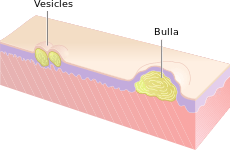Vesiculobullous disease
| Vesiculobullous disease |
|---|
|
Diagram showing cross section of vesicles (left) and bullae (right) on skin. |
| Classification and external resources |
|---|
| ICD-10 |
L10-L14 |
|---|
| ICD-9 |
694 |
|---|
| MeSH |
D012872 |
|---|
A vesiculobullous disease is a type of mucocutaneous disease that is characterized by vesicles and bullae (i.e. blisters). Both vesicles and bullae are fluid-filled lesions, and they are distinguished by size (vesicles being less than 5-10 mm and bulla being larger than 5-10 mm, depending upon what definition is used). In the case of vesiculobullous diseases which are also immune disorders, the term immunobullous,[1] is sometimes used. Example vesiculobullous diseases include:
- Infectious: (viral)
- Immunobullous:
- Genetic:
Some features are as follows:
References
- ↑ Magro, C. M.; Roberts-Barnes, J.; Crowson, A. N. (2012). "Direct Immunofluorescence Testing in the Diagnosis of Immunobullous Disease, Collagen Vascular Disease, and Vascular Injury Syndromes". Dermatologic Clinics 30 (4): 763–798, viii. doi:10.1016/j.det.2012.06.008. PMID 23021058.
- ↑ Williams DM (December 1989). "Vesiculobullous mucocutaneous disease: pemphigus vulgaris". J. Oral Pathol. Med. 18 (10): 544–53. PMID 2695619.
- ↑ Rao R, Prabhu SS, Sripathi H, Gupta S (2008). "Vesiculobullous lesions in lipoid proteinosis: a case report". Dermatol. Online J. 14 (7): 16. PMID 18718200.
|
|---|
| Acantholysis
(epidermis) | |
|---|
| Pemphigoid
(dermis) | |
|---|
| | Other bullous | |
|---|
| In diseases
classified elsewhere | |
|---|
| |
|---|
| | Description |
- Anatomy
- Physiology
- Development
|
|---|
| | Disease |
- Infections
- Vesiculobullous
- Dermatitis and eczema
- Papulosquamous
- Urticaria and erythema
- Radiation-related
- Pigmentation
- Mucinoses
- Keratosis, ulcer, atrophy, and necrobiosis
- Vasculitis
- Fat
- Neutrophilic and eosinophilic
- Congenital
- Neoplasms and cancer
- nevi and melanomas
- epidermis
- dermis
- Symptoms and signs
- Terminology
|
|---|
| | Treatment |
- Procedures
- Drugs
- antibiotics
- disinfectants
- emollients and protectives
- itch
- psoriasis
- other
- Wound and ulcer
|
|---|
|
|
